Attached files
| file | filename |
|---|---|
| 8-K - 8-K - SELECTA BIOSCIENCES INC | selectabiosciences8k_inves.htm |

Stifel 2017 Healthcare Conference
Nasdaq: SELB
November 14, 2017

Safe Harbor / Disclaimer
2
Any statements in this presentation about the future expectations, plans and prospects of Selecta Biosciences, Inc. (“the company”), including without limitation, the
progress of the Phase 1/2 clinical program of SEL-212, the potential of SEL-212 to treat severe gout patients and resolve their debilitating symptoms, the ability of
SVP-Rapamycin to induce immune tolerance against pegsiticase or otherwise reduce immunogenicity, the ability of SEL-212 to improve acute symptoms during a
short induction cycle, the ability of SEL-212 to be re-administered if severe gout symptoms recur, the company’s plans to add additional cohorts to the Phase 2 trial for
SEL-212, whether higher level doses of SVP-Rapamycin or SEL-212 will show increased clinical activity and durability in line with the Phase 1b, whether the company
will determine an appropriate dose of SEL-212 for the Phase 3, whether the patient population for a Phase 3 for SEL-212 has a rapid enrollment potential, when the
company will advance to a Phase 3 for SEL-212 (if at all), whether SEL-212 has the potential to address the unmet needs of gout patients, whether SEL-212 holds
billion dollar potential, the ability of the company’s SVP platform, including SVP-Rapamycin, to mitigate immune response and create better therapeutic outcomes or to
improve the efficacy or safety of existing biologics, the potential treatment applications for products utilizing the SVP platform in areas such as enzyme therapy, gene
therapy, oncology therapy, vaccines and treatments for allergies and autoimmune diseases, the potential of future collaborations, partnerships or licenses based on
the ability of SVP-Rapamycin, the potential of the SVP-Rapamycin platform generally, the company's expectations about receiving additional payments from Spark
Therapeutics, Inc. under the license agreement and/or the stock purchase agreement, the sufficiency of the company’s cash, cash equivalents, investments, and
restricted cash and other statements containing the words “anticipate,” “believe,” “continue,” “could,” “estimate,” “expect,” “hypothesize,” “intend,” “may,” “plan,”
“potential,” “predict,” “project,” “should,” “target,” “would,” and similar expressions, constitute forward-looking statements within the meaning of The Private Securities
Litigation Reform Act of 1995. Actual results may differ materially from those indicated by such forward-looking statements as a result of various important factors,
including, but not limited to, the following: the uncertainties inherent in the initiation, completion and cost of clinical trials including their uncertain outcomes, the
availability and timing of data from ongoing and future clinical trials and the results of such trials, whether preliminary results from a particular clinical trial will be
predictive of the final results of that trial or whether results of early clinical trials will be indicative of the results of later clinical trials, the unproven approach of the
company’s SVP technology, potential delays in enrollment of patients, undesirable side effects of the company’s product candidates, its reliance on third parties to
manufacture its product candidates and to conduct its clinical trials, the company’s inability to maintain its existing or future collaborations or licenses, its inability to
protect its proprietary technology and intellectual property, potential delays in regulatory approvals, the availability of funding sufficient for its foreseeable and
unforeseeable operating expenses and capital expenditure requirements, substantial fluctuation in the price of its common stock, a significant portion of the company’s
total outstanding shares have recently become eligible to be sold into the market, and other important factors discussed in the “Risk Factors” section of the company’s
Quarterly Report on Form 10-Q filed with the Securities and Exchange Commission, or SEC, on November 7, 2017, and in other filings that the company makes with
the SEC. In addition, any forward-looking statements included in this presentation represent the company’s views only as of the date of its publication and should not
be relied upon as representing its views as of any subsequent date. The company specifically disclaims any obligation to update any forward-looking statements
included in this presentation.

Corporate Overview
3
• Clinical-stage company applying proprietary Synthetic Vaccine Particle (SVP™) platform to
avoid unwanted immunogenicity and unlock the full potential of biologic therapies.
• Focused on SEL-212 (pegsiticase administered with SVP-Rapamycin); designed to be the
first non-immunogenic uricase treatment for chronic severe gout
- Phase 2 dose/regimen-finding study: SEL-212 is clinically active and generally well tolerated at 0.08 and 0.1 mg/kg
doses of SVP-Rapamycin
- Cohorts receiving 0.125 and 0.15 mg/kg doses of SVP-Rapamycin ongoing; expect increased clinical activity and
durability in line with Phase 1b; plan to report initial data in Q1 2018
- Additional patient cohorts to test combination therapy for the entire treatment period planned for Q1 2018
- Plan to enter Phase 3 in 2018, consistent with previous guidance
• Advancing other proprietary product candidates utilizing SVP technology platform
• Potential for additional partnerships and licenses in a range of therapeutic areas

Preventing Unwanted Immunogenicity via Selecta’s
SVP-Rapamycin Technology Platform
4
Spleen
Preventing ADAs
Inducing a tolerogenic
response to a biologic
drug (antigen)
Implementing
the
message
Sending precise
instructions
Targeting
immune cells
• By dosing “free biologic”
separate from SVP-
Rapamycin,
it distributes broadly to desired
sites of action
• Some of the biologic co-
localizes with dendritic cells
that have taken up SVP-
Rapamycin
• The dendritic cells then induce
regulatory T cells that circulate
throughout the body and
suppress immune responses
against the biologic (i.e. ADAs)
Naïve T cell
B cell
Helper T cell
Dendritic cell
Regulatory
T cell
Potential to enable new therapies and improve efficacy/safety of existing biologics
SVP-Rapamycin Biologic drug
Kishimoto et al., Improving the efficacy and safety of biologic drugs with tolerogenic nanoparticles, Nature Nanotechnology, Aug. 2016

SEL-212 for Chronic
Severe Gout

SEL-212: Advancing a Potential New Treatment Option
for Chronic Severe Gout Patients Toward Phase 3
6
Rare and Serious Disease
• ~160,000 adults with chronic severe gout treated by U.S. rheumatologists
• Debilitating flares and joint-damaging arthritis caused by uric acid deposits; risk of renal and cardiovascular disease
Immunogenicity Barrier
• Uricases are highly effective in breaking down uric acid deposits, but are foreign to the human immune system, causing
immunogenicity that can negate efficacy and present safety risks
Clear Clinical Path
• Serum uric acid level reduction – a robust FDA/EMA primary endpoint for approval – can be seen rapidly upon dosing, easy
to measure, maintenance strongly correlated with low/negative ADA titers
• Adult patient population with rapid enrollment potential
Ownership
• In-licensed pegsiticase in 2014; combined with SVP-Rapamycin to form SEL-212
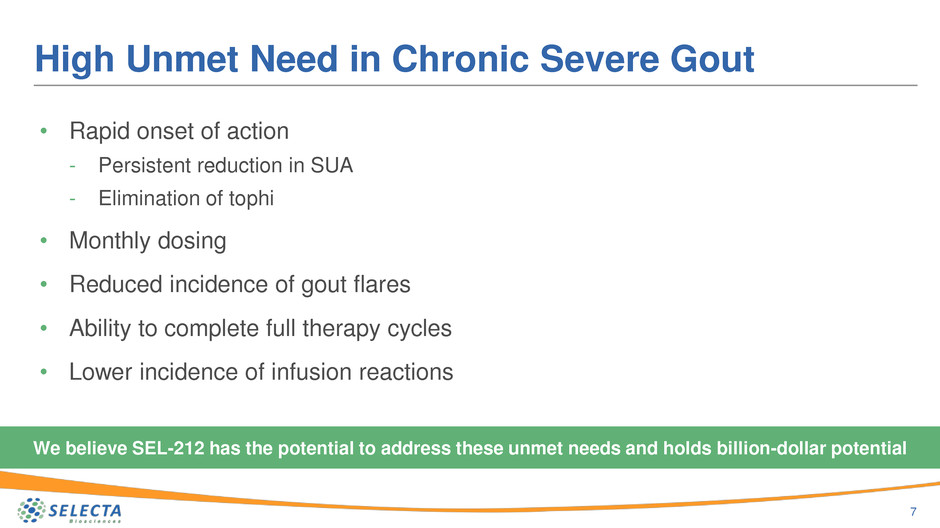
High Unmet Need in Chronic Severe Gout
• Rapid onset of action
- Persistent reduction in SUA
- Elimination of tophi
• Monthly dosing
• Reduced incidence of gout flares
• Ability to complete full therapy cycles
• Lower incidence of infusion reactions
7
We believe SEL-212 has the potential to address these unmet needs and holds billion-dollar potential

Phase 1b Single Dose Patient Cohorts
8
IMVACS 2016 Presentation. Clinicaltrials.gov NCT02648269
S
e
ru
m
U
ric
A
cid
(
m
g
/d
L
)
0.03 mg/kg
0.4 mg/kg
0.1 mg/kg
0.4 mg/kg
0.4 mg/kg
0.3 mg/kg
0.4 mg/kg
0.15 mg/kg
0.4 mg/kg
0
2
4
6
8
1 0
0
2
4
6
8
1 0
0
2
4
6
8
1 0
0
2
4
6
8
1 0
0
2
4
6
8
1 0
N = 5
N = 5
N = 10
N = 5
N = 5
= Pegsiticase; = SVP-Rapamycin
Days
S
in
g
le
Dos
e
0%
70%
100%
100%
20%
% Patients
sUA < 6mg/dL
0 7 14 21 30
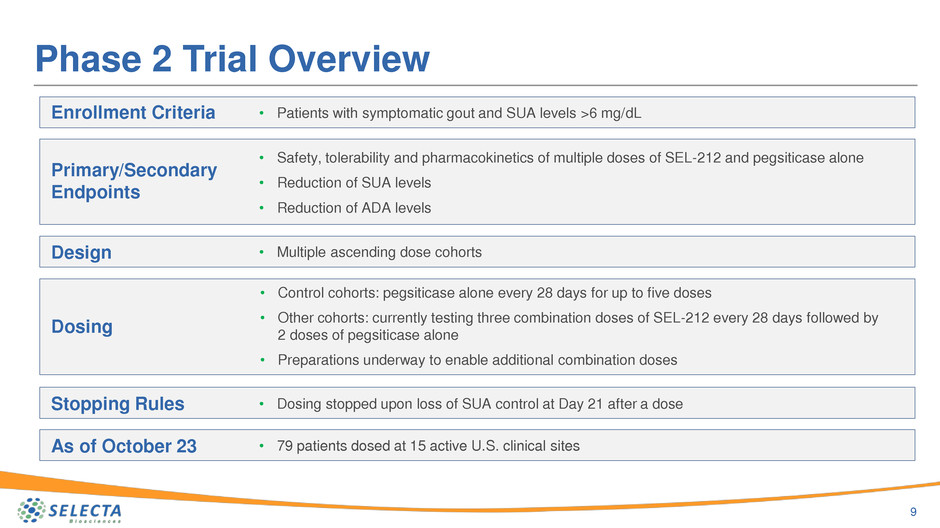
Phase 2 Trial Overview
9
Enrollment Criteria
Primary/Secondary
Endpoints
Design
Dosing
Stopping Rules
As of October 23
• Patients with symptomatic gout and SUA levels >6 mg/dL
• Safety, tolerability and pharmacokinetics of multiple doses of SEL-212 and pegsiticase alone
• Reduction of SUA levels
• Reduction of ADA levels
• Multiple ascending dose cohorts
• Control cohorts: pegsiticase alone every 28 days for up to five doses
• Other cohorts: currently testing three combination doses of SEL-212 every 28 days followed by
2 doses of pegsiticase alone
• Preparations underway to enable additional combination doses
• Dosing stopped upon loss of SUA control at Day 21 after a dose
• 79 patients dosed at 15 active U.S. clinical sites
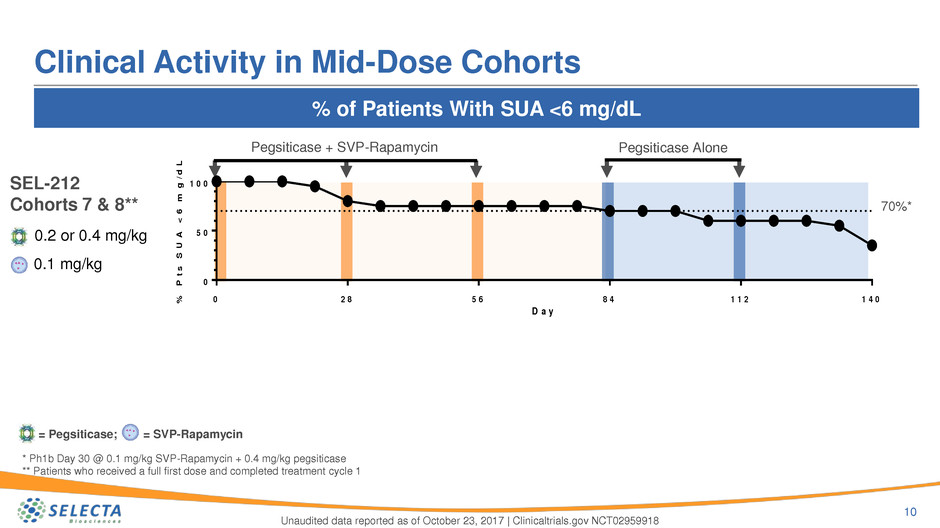
% of Patients With SUA <6 mg/dL
Clinical Activity in Mid-Dose Cohorts
10
Unaudited data reported as of October 23, 2017 | Clinicaltrials.gov NCT02959918
70%*
Pegsiticase + SVP-Rapamycin
0.1 mg/kg
0.2 or 0.4 mg/kg
Pegsiticase Alone
SEL-212
Cohorts 7 & 8**
0
5 0
1 0 0
D a y
% P
ts S
UA
<6
mg
/dL
0 2 8 5 6 8 4 1 1 2 1 4 0
* Ph1b Day 30 @ 0.1 mg/kg SVP-Rapamycin + 0.4 mg/kg pegsiticase
** Patients who received a full first dose and completed treatment cycle 1
= Pegsiticase; = SVP-Rapamycin

0.2 or 0.4 mg/kg
Pegsiticase Alone
Pegsiticase alone
Cohorts 1 & 2
% of Patients With SUA <6 mg/dL
Comparison With Control Cohorts Indicates
Immune Tolerance
11
Unaudited data reported as of October 23, 2017 | Clinicaltrials.gov NCT02959918
* Ph1b Day 30 @ 0.1 mg/kg SVP-Rapamycin + 0.4 mg/kg pegsiticase
** Patients who received a full first dose and completed treatment cycle 1
= Pegsiticase; = SVP-Rapamycin
70%*
Pegsiticase + SVP-Rapamycin
0.1 mg/kg
0.2 or 0.4 mg/kg
Pegsiticase Alone
SEL-212
Cohorts 7 & 8**
0
5 0
1 0 0
D a y
% P
ts S
UA
<6
mg
/dL
0 2 8 5 6 8 4 1 1 2 1 4 0
0
5 0
1 0 0
D a y
%
P
ts
S
U
A
<
6
m
g
/d
L
0 2 8

0 7 1 4 2 1 2 8 3 5 4 2 4 9 5 6 6 3 7 0 7 7 8 4 9 1 9 8 1 0 5 1 1 2 1 1 9 1 2 6 1 3 3 1 4 0
0
2
4
6
8
1 0
1 0
2
1 0
3
1 0
4
1 0
5
0 7 1 4 2 1 2 8 3 5 4 2 4 9 5 6 6 3 7 0 7 7 8 4 9 1 9 8 1 0 5 1 1 2 1 1 9 1 2 6 1 3 3 1 4 0
0
2
4
6
8
1 0
1 0
2
1 0
3
1 0
4
1 0
5
0 7 1 4 2 1 2 8 3 5 4 2 4 9 5 6 6 3 7 0 7 7 8 4 9 1 9 8 1 0 5 1 1 2 1 1 9 1 2 6 1 3 3 1 4 0
0
2
4
6
8
1 0
1 0
2
3
4
5
0 7 1 4 2 1 2 8 3 5 4 2 4 9 5 6 6 3 7 0 7 7 8 4 9 1 9 8 1 0 5 1 1 2 1 1 9 1 2 6 1 3 3 1 4 0
0
2
4
6
8
1 0
1 0
2
3
4
5
0 7 1 4 2 1 2 8 3 5 4 2 4 9 5 6 6 3 7 0 7 7 8 4 9 1 9 8 1 0 5 1 1 2 1 1 9 1 2 6 1 3 3 1 4 0
0
2
4
6
8
1 0
1 0
2
3
4
5
0 7 1 4 2 1 2 8 3 5 4 2 4 9 5 6 6 3 7 0 7 7 8 4 9 1 9 8 1 0 5 1 1 2 1 1 9 1 2 6 1 3 3 1 4 0
0
2
4
6
8
1 0
1 0
2
3
4
5
0 7 1 4 2 1 2 8 3 5 4 2 4 9 5 6 6 3 7 0 7 7 8 4 9 1 9 8 1 0 5 1 1 2 1 1 9 1 2 6 1 3 3 1 4 0
0
2
4
6
8
1
1 0
2
3
4
5
0 7 1 4 2 1 2 8 3 5 4 2 4 9 5 6 6 3 7 0 7 7 8 4 9 1 9 8 1 0 5 1 1 2 1 1 9 1 2 6 1 3 3 1 4 0
0
2
4
6
8
1
1 0
2
3
4
5
0 7 1 4 2 1 2 8 3 5 4 2 4 9 5 6 6 3 7 0 7 7 8 4 9 1 9 8 1 0 5 1 1 2 1 1 9 1 2 6 1 3 3 1 4 0
0
2
4
6
8
1
1 0
2
3
4
5
0 7 1 4 2 1 2 8 3 5 4 2 4 9 5 6 6 3 7 0 7 7 8 4 9 1 9 8 1 0 5 1 1 2 1 1 9 1 2 6 1 3 3 1 4 0
0
2
4
6
8
1
1 0
2
3
4
5
0 7 1 4 2 1 2 8 3 5 4 2 4 9 5 6 6 3 7 0 7 7 8 4 9 1 9 8 1 0 5 1 1 2 1 1 9 1 2 6 1 3 3 1 4 0
0
2
4
6
8
1
1 0
2
3
4
5
#
♦
*
+
#114-0004
111-0004
103-0018
104-1014
106-1039
105-0001
114-0007
104-0019
104-0024
104-0020
114-0009
S
e
ru
m
U
ric
A
cid
(
m
g
/d
L
) A
n
ti-U
ricas
e
A
n
ti
b
o
d
y
T
it
e
r
Cohort 7
0.2 mg/kg Pegsiticase + 0.1 mg/kg SVP-Rapamycin
12* #♦
Patient
Unaudited data reported as of October 23, 2017 | Clinicaltrials.gov NCT02959918
Pegsiticase AlonePegsiticase + SVP-Rapamycin
Day
0.1 mg/kg
0.2 mg/kg
Discontinuation due to infusion reaction Withdrawal of consent SAE; infusion reaction Stopping rules met+

0 7 1 4 2 1 2 8 3 5 4 2 4 9 5 6 6 3 7 0 7 7 8 4 9 1 9 8 1 0 5 1 1 2 1 1 9 1 2 6 1 3 3 1 4 0
0
2
4
6
8
1 0
1 0
2
1 0
3
1 0
4
1 0
5
0 7 1 4 2 1 2 8 3 5 4 2 4 9 5 6 6 3 7 0 7 7 8 4 9 1 9 8 1 0 5 1 1 2 1 1 9 1 2 6 1 3 3 1 4 0
0
2
4
6
8
1 0
1 0
2
1 0
3
1 0
4
1 0
5
0 7 1 4 2 1 2 8 3 5 4 2 4 9 5 6 6 3 7 0 7 7 8 4 9 1 9 8 1 0 5 1 1 2 1 1 9 1 2 6 1 3 3 1 4 0
0
2
4
6
8
1 0
1 0
2
3
4
5
0 7 1 4 2 1 2 8 3 5 4 2 4 9 5 6 6 3 7 0 7 7 8 4 9 1 9 8 1 0 5 1 1 2 1 1 9 1 2 6 1 3 3 1 4 0
0
2
4
6
8
1 0
1 0
2
3
4
5
0 7 1 4 2 1 2 8 3 5 4 2 4 9 5 6 6 3 7 0 7 7 8 4 9 1 9 8 1 0 5 1 1 2 1 1 9 1 2 6 1 3 3 1 4 0
0
2
4
6
8
1 0
1 0
2
3
4
5
0 7 1 4 2 1 2 8 3 5 4 2 4 9 5 6 6 3 7 0 7 7 8 4 9 1 9 8 1 0 5 1 1 2 1 1 9 1 2 6 1 3 3 1 4 0
0
2
4
6
8
1 0
1 0
2
3
4
5
0 7 1 4 2 1 2 8 3 5 4 2 4 9 5 6 6 3 7 0 7 7 8 4 9 1 9 8 1 0 5 1 1 2 1 1 9 1 2 6 1 3 3 1 4 0
0
2
4
6
8
1 0
1 0
2
3
4
5
0 7 1 4 2 1 2 8 3 5 4 2 4 9 5 6 6 3 7 0 7 7 8 4 9 1 9 8 1 0 5 1 1 2 1 1 9 1 2 6 1 3 3 1 4 0
0
2
4
6
8
1
1 0
2
3
4
5
0 7 1 4 2 1 2 8 3 5 4 2 4 9 5 6 6 3 7 0 7 7 8 4 9 1 9 8 1 0 5 1 1 2 1 1 9 1 2 6 1 3 3 1 4 0
0
2
4
6
8
1
1 0
2
3
4
5
0 7 1 4 2 1 2 8 3 5 4 2 4 9 5 6 6 3 7 0 7 7 8 4 9 1 9 8 1 0 5 1 1 2 1 1 9 1 2 6 1 3 3 1 4 0
0
2
4
6
8
1
1 0
2
3
4
5
0 7 1 4 2 1 2 8 3 5 4 2 4 9 5 6 6 3 7 0 7 7 8 4 9 1 9 8 1 0 5 1 1 2 1 1 9 1 2 6 1 3 3 1 4 0
0
2
4
6
8
1
1 0
2
3
4
5
0 7 1 4 2 1 2 8 3 5 4 2 4 9 5 6 6 3 7 0 7 7 8 4 9 1 9 8 1 0 5 1 1 2 1 1 9 1 2 6 1 3 3 1 4 0
0
2
4
6
8
1
1 0
2
3
4
5
13
104-0018
110-0015
103-0020
104-0017
106-0054
106-0045
107-0008
103-0019
111-0008
104-0023
106-0065
106-0064
*
#
#
#
#
*
ϴ
ϴ
Cohort 8
0.4 mg/kg Pegsiticase + 0.1 mg/kg SVP-Rapamycin
Unaudited data reported as of October 23, 2017 | Clinicaltrials.gov NCT02959918
Patient
S
e
ru
m
U
ric
A
cid
(
m
g
/d
L
) A
n
ti-U
ricas
e
A
n
ti
b
o
d
y
T
it
e
r
0.1 mg/kg
0.4 mg/kg
Pegsiticase AlonePegsiticase + SVP-Rapamycin
Day
SAE; not study drug related SAE; infusion reaction Stopping rules metϴ * #

1 1 2 3 4 5
0
2 0
4 0
6 0
Low Frequency of Gout Flares Observed with
SEL-212 Treatment
14
• Data indicate SEL-212 lowers flares initially and over time during treatment
• Urate lowering therapies typically increase the incidence of flares at the beginning of therapy
Unaudited data as of October 23, 2017 | Clinicaltrials.gov NCT02959918
% o
f
P
at
ie
n
ts
w
/Fl
a
re
Pegsiticase
Alone
% of Patients Experiencing Flares by Month
SEL-212
Month
50%
24%
16%
3%
11%
5%
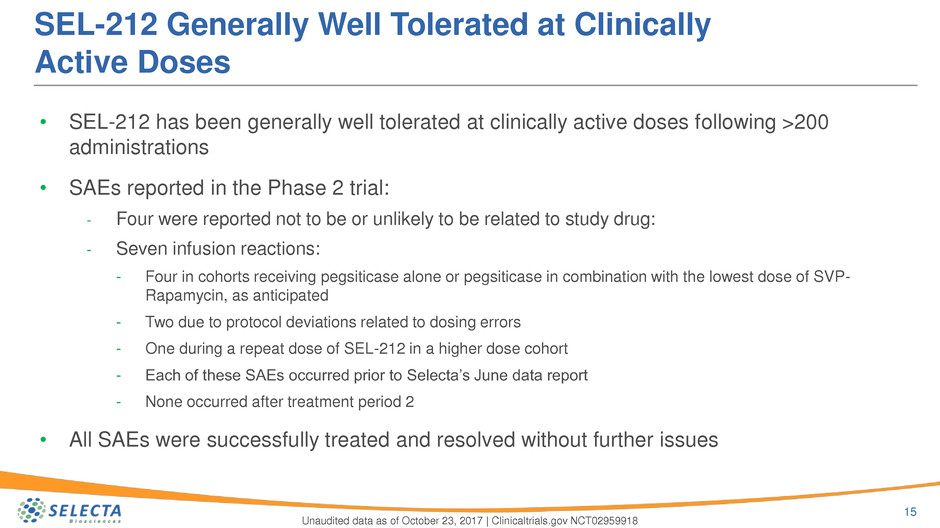
SEL-212 Generally Well Tolerated at Clinically
Active Doses
15
• SEL-212 has been generally well tolerated at clinically active doses following >200
administrations
• SAEs reported in the Phase 2 trial:
- Four were reported not to be or unlikely to be related to study drug:
- Seven infusion reactions:
- Four in cohorts receiving pegsiticase alone or pegsiticase in combination with the lowest dose of SVP-
Rapamycin, as anticipated
- Two due to protocol deviations related to dosing errors
- One during a repeat dose of SEL-212 in a higher dose cohort
- Each of these SAEs occurred prior to Selecta’s June data report
- None occurred after treatment period 2
• All SAEs were successfully treated and resolved without further issues
Unaudited data as of October 23, 2017 | Clinicaltrials.gov NCT02959918

SEL-212 Expected to Enter Phase 3 in 2018
16
• Focused on SEL-212 (pegsiticase administered with SVP-Rapamycin);
designed to be the first non-immunogenic uricase treatment for chronic
severe gout
- Phase 2 dose/regimen-finding study: SEL-212 is clinically active and generally well
tolerated at 0.08 and 0.1 mg/kg doses of SVP-Rapamycin
- Cohorts receiving 0.125 and 0.15 mg/kg doses of SVP-Rapamycin ongoing; expect
increased clinical activity and durability in line with Phase 1b; plan to report initial
data in Q1 2018
- Additional patient cohorts to test combination therapy for the entire treatment period
planned for Q1 2018
- Plan to enter Phase 3 in 2018, consistent with previous guidance

SEL-212 Program is Informing the Development
of Other Product Candidates
17
Chronic Therapies+
Proprietary program Potential program
Single
Treatment
Chronic
Treatment
Adult Patients with
Chronic Conditions
Cancer Patients Pediatric Patients with
Life-Threatening Conditions
Oncology (SEL-403)
Treatment
Cycle +
Gene Therapy
(SEL-302 & SEL-313)+
SEL-212 for Chronic Severe Gout
+
• SVP platform holds great potential
• SEL-212 program informing other programs with
data from >100 patients
• Current clinical data demonstrate ADA
prevention and support development of our near-
term pipeline
TBD

Spark Therapeutics License Agreement
18
• December 2016 agreement provides Spark Therapeutics with
exclusive worldwide rights to Selecta's SVP technology for up
to five gene therapy targets
• Initial focus on combination of SVP with Spark’s Hemophilia A
gene therapy
• Among the largest gene therapy and SMID-cap to SMID-cap biotech deals announced to
date
• Subject to the terms of the license agreement, Spark agreed to pay to Selecta:
- $30 million of initial cash payments and investments in Selecta equity; final $7.5 million received on Oct. 31, 2017
- Up to $430 million in milestone payments for each target
- Mid-single to low-double-digit royalties on worldwide annual net sales of any resulting commercialized gene therapy

3Q17 Financial Overview
19
For the Quarter Ended
(In thousands, except share and per share data)
September 30,
2017
September 30,
2016
Grant & Collaboration Revenue $27 $1,048
Research & Development Expenses 9,504 6,021
General & Administrative Expenses 4,377 2,495
Net Loss Attributable to Common Stockholders $(14,676) $(7,728)
Net Loss Per Basic & Diluted Share $(0.66) $(0.43)
Wtd. Avg. Common Shares Outstanding – Basic & Diluted 22,082,207 18,108,014
As of
(In thousands)
September 30,
2017
June 30,
2017
Cash, Cash Equivalents, Marketable Securities, Restricted Cash $104,780 $113,045
Cash runway into mid-2019
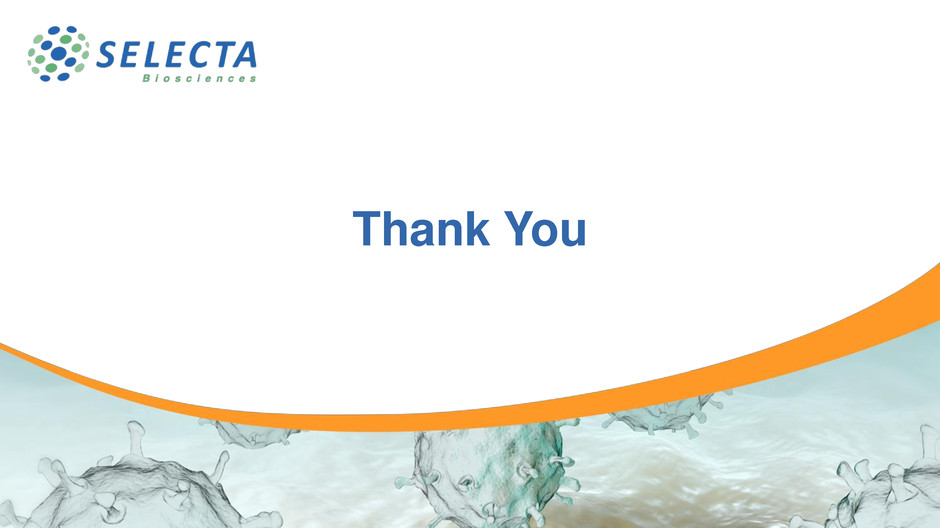
Thank You
